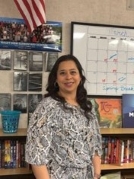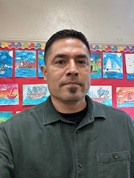


Left to right: Bilingual authorization candidates Lorena Guerrero, Yanfang Yang, and Carlos Campa.
Bilingual authorization teaching candidates across the state are currently leveraging their linguistic skills in K-12 classrooms to advance the academic and social success of multilingual students.
The teaching candidates are completing their field experience, a real-world requirement of the Commission’s revised 2021 Bilingual Authorization Program Standards and new Bilingual Teaching Performance Expectations (BTPEs).
The field experience provides candidates with flexibility and opportunities to experience teaching in different language immersion settings at different grade levels while concurrently working on their teaching credential(s) or adding a bilingual authorization for teachers who already hold a teaching credential.
“To increase the state's bilingual teaching workforce, we must rethink the meaning of being bilingual and biliterate,” said Fernando Rodríguez-Valls, professor and bilingual authorization program coordinator at California State University, Fullerton, home to one of California’s 48 bilingual teacher preparation programs.
“Many potential bilingual candidates are the byproduct of an English-only system that has questioned the value of their linguistic repertoires and languaging practices. The bilingualism candidates bring to the credential programs showcases their linguistic richness and knowledge.”
Two such candidates are Carlos Campa and Lorena Guerrero, first-generation Mexican Americans and experienced educators whose similar paths led them to pursue bilingual authorizations in Spanish at CSU Fullerton.
“Some (of my) students were caught between two worlds that left them with limited Spanish and English language abilities,” said Campa, who is completing his field experience at Willard F. Payne Elementary School in El Monte, where he teaches.
“As a child, I felt that I lost out on part of my connection to the Spanish language and in turn the culture. As a young adult, I tried to piece back together what I felt I lost early on. If I can help another child keep that connection with their Spanish from ever being lost and they can continue into adulthood and throughout, I’ll feel this was a success.”
Guerrero, a sixth-grade teacher at Baldy View Elementary School in Upland, views earning her bilingual authorization as an investment in the future of students and society.
“By providing ALL students with access to high-quality bilingual education, we, as educators and advocates, are empowering them to reach their full potential and become active and engaged citizens,” Guerrero said.
“I am grateful for schools that are promoting and encouraging Dual Language Immersion and the use of other languages, and I am grateful for universities that find a bilingual authorization to be important and necessary for the preparation of the next generation of citizens in our country.”
Further north at the University of California, Davis, Yanfang Yang is earning her bilingual authorization in Mandarin. Yang is a student teacher at William Land Elementary in Sacramento where she is co-teaching in Mandarin Immersion Programs.
“I grew up in a single-parent home in China’s deaf community, the first in my family to attend university, and those early years navigating communication challenges really shaped who I am,” Yang said.
“At sixteen, I started Sunflower, a high school student organization in Xiamen, China, to tutor underprivileged kids—some with mild hearing issues, others left with grandparents because their parents moved to cities for work. Watching those children light up as education opened doors for them, especially with language support, sparked something in me.”
Yang, who is trilingual in Mandarin, Taiwanese, and English, said that at William Land Elementary, she has already seen how Mandarin Immersion Program students flourish when taught in their native language while acquiring English, fostering both academic success and cultural pride.
“Having a society that promotes and supports plurilingualism exemplifies its commitment to language justice and linguistic equity, diversity, and inclusion,” Rodríguez-Valls said.
“Going beyond neoliberal ideologies that conceptualize bilingualism as a market product, allocating funding in the state budget to support plurilingualism creates opportunities for students to develop linguistic activism and feel confident to fully use their linguistic repertoires.”
The BTPEs support the goals of the California Department of Education’s Global California 2030 plan to significantly increase the number of dual language immersion programs, enable half of all K-12 students to gain proficiency in two or more languages, and increase the yearly number of bilingual teacher authorizations.
The Commission has focused a variety of activities on addressing and improving preparation for meeting the needs of students who are English learners and on updating the knowledge and skills required of individuals who teach or provide services to these students.
For guidance on how to obtain a bilingual authorization, interested educators may visit the Commission’s website.
Additional content: Read more about the journeys and experiences that led Campa, Guerrero, and Yang, to pursue their bilingual authorizations.
.png?sfvrsn=c28b72b1_10)
.png?sfvrsn=cd8b72b1_0)